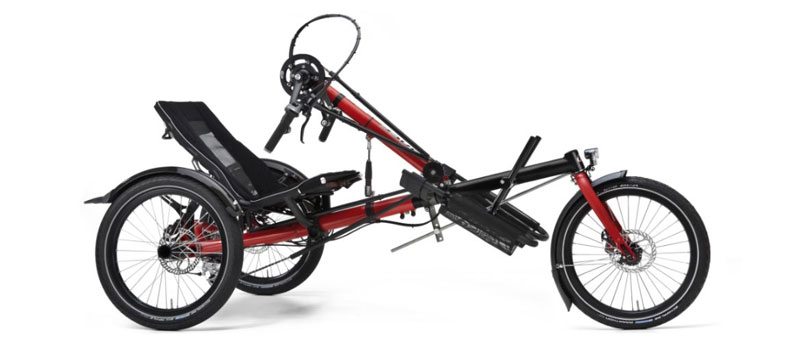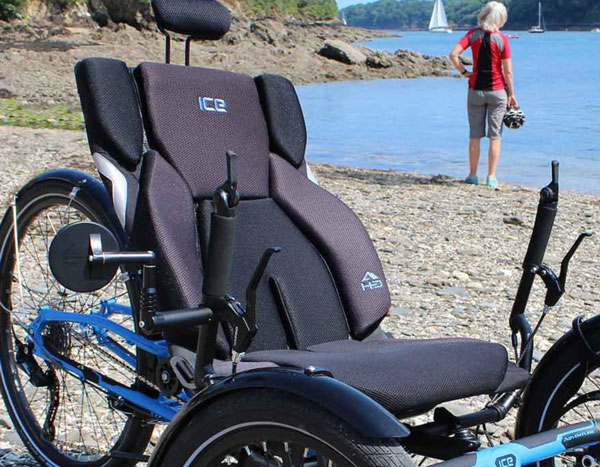Recumbent trikes are an effective tool for rehabilitation!
Recumbents are now being used by many people with a wide variety of conditions as part of their rehabilitation journey.
Using a recumbent as a rehabilitation tool can have monumental benefits as trikes allow participants to focus on:
- functional mobility (the ability to move from one place to another to complete an activity or task)
- strength,
- endurance,
- motor planning (the ability to coordinate sequential muscle movements),
- balance.
Why are Recumbents Perfect for Rehabilitation?
There are many other reasons why recumbent trikes are perfect for rehabilitation.
Here are a few to get the ball (or in this case the trike) rolling …
18 Benefits of Using Recumbent Trikes for Rehabilitation:
1. Reduction of depression
Exercise helps to lift mood, improves sleeping patterns and increases energy levels. It also helps to block negative thoughts and provides a distraction from worries.
- help lift mood through improved fitness
- help improve sleeping patterns
- increase energy levels
- help block negative thoughts or distract people from daily worries
- help people feel less alone if they exercise with others.
2. Alleviation of stress and anxiety
Research indicates that exercise may help to change the levels of chemicals in the brain such as endorphins, stress hormones and serotonin.
3. Removal of fear of falling.
Recumbents are extremely stable and comfortable. You can’t fall off a recumbent trike without going to extreme lengths to do so.

4. Challenges Disability
cycling encourages riders to challenge their disability, rather than being limited by it, and to get outside and enjoy the great outdoors. This is important as it directly affects a person’s self-esteem and self-worth.
In the case of tandem riders, the challenge may be to keep up with the faster partner.
5. Anger management
Exercise is a positive way to channel thoughts and manager anger issues which may arise due to life circumstances and challenges.
6. Improved concentration
Researchers (from the University of British Columbia), found that regular aerobic exercise, seems to increase the size of the hippocampus, the brain area involved in verbal memory and learning.
7. Repetition of movement.
Often physiotherapists require clients to repeat a movement over and over to retrain the brain, nerves and muscles. Cycling does this very effectively in a fun and enjoyable way as it involves hundreds and hundreds of repetitions in a short amount of time, Cycling also allows the stronger leg to assist the weaker leg when pedalling
8. Fitness
Cycling raises fitness levels which positively affects all areas of the body and soul.
9. Positive focus
The trike itself, the passing scenery, as well as the activity of cycling, gives riders something positive to focus. Exercise helps to block negative thoughts and provides a distraction from daily worries. Get two people together and you can exponentially increase the positive aspects.
10. Increased Ease of Movement.
Cycling helps to Increase the connectivity between parts of the brain responsible for motor ability
11. Social interaction.
Recumbents allow riders to get out into their community.
12. And independence
Recumbent trikes encourage individuals to take control of their own therapy as they become more involved. This results in an increased sense of independence which is essential for everyone’s self-esteem and well-being.
We recently helped a young man get into a recumbent trike as part of his rehabilitation programme. For over a year, he relied on others to help him move from one place to another. However, when he first sat in a recumbent trike, he was in control of where he went and when (pedalling, steering and braking) for the first time in a year. His independence was being restored. The smile on his face was indescribable!
13. Recumbents Don’t Look Like Disability Equipment
Recumbent trikes look cool. People will often ask about the trikes as the recumbents are unusual. This takes the focus off the disability and puts the rider in the position of being out using recreational equipment as opposed to disability equipment. This in turn positively affects they way they see themselves (self-esteem and self-image).
14. Recumbent trikes can be modified
Trikes can be equipped and adapted in many ways to meet the rehabilitation needs of the rider. For example, trikes can be set up to include:
- one-handed control (for steering, brakes, gears and electric assist)
- tandem riders (providing extra support and guidance for the rehabilitee). Almost anyone can participate in cycling with a tandem option. An electric assist motor on the leading trike will help if the tag-along rider needs an extra ‘pull’.
- seat-belts (for added support)
- walking stick/frame mounts
- calf-support pedals (help to keep legs in stabilized position)
- wrist/arm supports
- electric assist (provides a bit of a ‘push’ which is great for hills or for when the rider tires but still needs to get home)

15. Recumbents are extremely stable and comfortable. The wide seat provides plenty of support for the buttocks and back. The trike is self-balancing, even when stationary.
16. Recumbent trikes are portable and can be used in different places (e.g., on paths by the beach/forest/park or on the road). There are also trikes available that work brilliantly on the beach itself and off-road! Recumbent trikes fold-up so they can easily be transported in the car boot. They will also fit (unfolded) in the back of a maxi-taxi.
17. Recumbent trikes improve the quality of life.
All in all, a recumbent trike is a very diverse piece of equipment. It can be a rehabilitation tool, an exercise machine as well as a mobility device.

18. Best of all, recumbent trikes make rehabilitation fun! Cycling is a fun social activity. It’s a great way to engage in rehabilitation activity as well as reconnecting with friends and family.

Will a Recumbent Trike work for You?
 Over the years, we have helped people from age 2 to 92 yrs, with many different conditions or needs, get into recumbent cycling. Cerebral palsy, stroke, Parkinson’s, nerve disorders, spinal cord injuries, spinal problems, balance issues, joint disorders, post-operative patients, and more.
Over the years, we have helped people from age 2 to 92 yrs, with many different conditions or needs, get into recumbent cycling. Cerebral palsy, stroke, Parkinson’s, nerve disorders, spinal cord injuries, spinal problems, balance issues, joint disorders, post-operative patients, and more.
Some say, “I’ll never be able to get into that thing”. Many said, “I’ll never be able to ride”. All bar one or two have found they could and the smile they wore on their faces was magical.
Talk with us today to find out how a recumbent trike may be the right tool for your rehabilitation. We’d love to work with you!
If your occupational therapist doesn’t suggest recumbent trikes, you should.